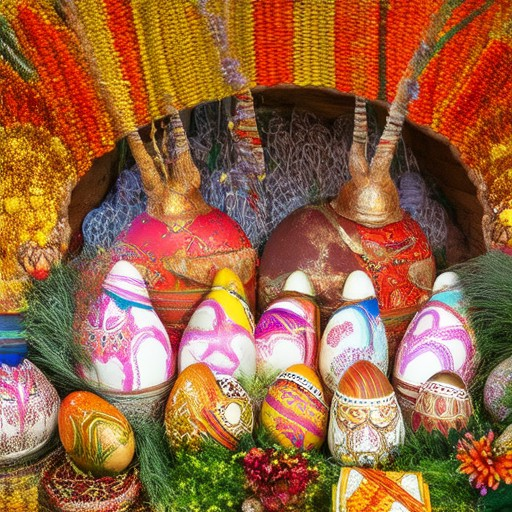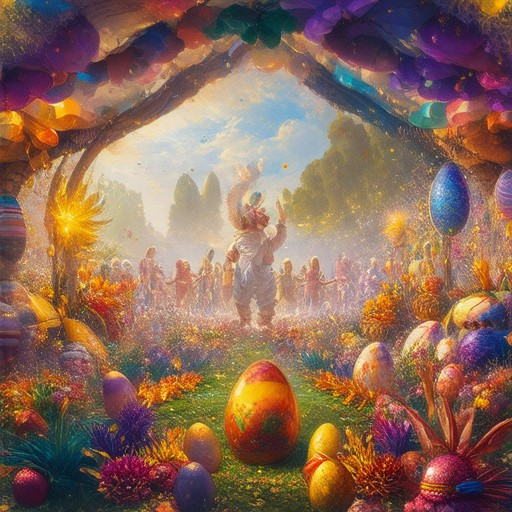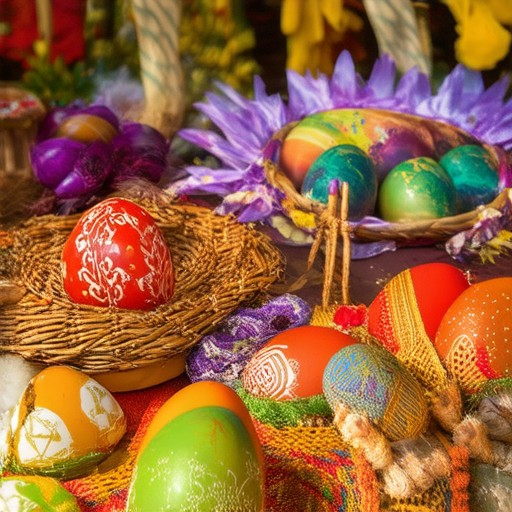Easter, a holiday marked by joy, reflection, and renewal, is celebrated in diverse ways across cultures and regions. From the vibrant traditions of Greek Easter, where families prepare for Tsoubou, to the colorful Semana Santa celebrations in Mexico, Easter is a time of rich cultural expression. Whether it’s the symbolic exchange of eggs in Orthodox Easter celebrations in Greece or the festive Easter egg hunts in many Western cultures, Easter celebrations around the world reflect deep historical, religious, and social meanings. This article delves into the fascinating traditions, history, and cultural practices surrounding Easter, exploring how it is celebrated in various parts of the globe and uncovering the stories behind its enduring legacy.

Easter Traditions
Easter is celebrated with a variety of customs and traditions that have been passed down through generations. These practices often vary by culture and region, but many share common themes of renewal, hope, and celebration of resurrection and rebirth.
1. Easter Egg Hunts
The tradition of hiding eggs and having children search for them is thought to date back to ancient Persia, where eggs were colored red to symbolize blood. In modern times, Easter egg hunts have become a beloved family tradition, often involving chocolate eggs and decorative baskets.
2. Dyeing Eggs
Egg dyeing is another long-standing Easter custom. The vibrant colors of dyed eggs are said to represent the beauty of spring and the renewal of life. Natural dyes, such as onion skins, grass, and flowers, were traditionally used before commercial dyes became popular.
3. Church Services
Attending church services is a significant part of Easter celebrations for many families. Services often include special music, readings, and sermons centered around the story of Jesus’ resurrection. Many churches also hold Easter brunches or dinners following the service.
4. Decorating Homes
People decorate their homes for Easter with things like Easter baskets, bunnies, and wreaths made of flowers. These decorations reflect the joy and happiness associated with the holiday.
5. Giving and Receiving Gifts
Easter is a time for giving and receiving gifts, particularly eggs and chocolates. This tradition is especially popular among children, who often leave out treats for the Easter Bunny in exchange for eggs.
6. Spring Cleaning
In many cultures, Easter is associated with spring cleaning and freshening up the home. This tradition reflects the symbolic importance of renewal and preparation for the coming year.
7. Community Events
Many communities host Easter parades, egg hunts, and other public events. These gatherings provide opportunities for families to come together and celebrate the holiday in a shared space.
8. Reflection and Gratitude
For some, Easter is a time to reflect on personal growth and gratitude. This reflection often ties into religious observances, emphasizing themes of second chances and new beginnings.
Learn more about our Easter celebrations at The Sacred Heart Church.
How Do We Celebrate Easter?
Easter is a significant holiday celebrated around the world, marked by various traditions and activities. At The Sacred Heart Church, we believe Easter is a time to come together in joy and reflection. Here’s how we celebrate:
Religious Traditions
For many, Easter commemorates the resurrection of Jesus Christ. This is central to our celebrations, often beginning with attending sunrise services or special masses. These services remind us of the hope and renewal that Easter brings.
Family and Community Activities
Our celebrations extend beyond worship. Families often gather for brunches, egg hunts, and other festive gatherings. Children enjoy painting Easter eggs, hunting for baskets, and participating in parades. These activities create lasting memories and strengthen bonds within our community.
Celebrating Together
We encourage everyone to join us for Easter Sunday services. The church is decorated beautifully, and we welcome visitors to share in the joy of the season. Afterward, many families stay for fellowship and Easter brunches hosted at local restaurants or potluck events.
Easter Food and Customs
Easter meals often include traditional dishes like lamb, fish, and unleavened bread, symbolizing the Last Supper. We also enjoy Easter candy and chocolates, sharing treats with loved ones and children.
Community Outreach
At The Sacred Heart Church, we believe in serving others. During Easter, we organize food drives and volunteer opportunities to ensure everyone enjoys the holiday. This reminds us of the importance of giving and caring for those in need.
- Attending Worship Services:** Join us for sunrise services or morning masses to reflect on the meaning of Easter.
- FAMILY ACTIVITIES:** Participate in egg hunts, Easter parades, and family brunches.
- CELEBRATING TOGETHER:** Share meals and fellowship with your community and extended family.
- EASTER CANDY AND GIFTS:** Exchange gifts and enjoy traditional Easter treats.
Visit our website for more details on Easter celebrations and how you can participate: Easter Celebrations .

Easter Celebrations in the Catholic Church
Catholics observe Easter with several traditions and ceremonies that highlight the significance of Christ’s resurrection. Here’s an overview of what Catholics typically do during Easter:
Easter Sunday
- Mass of the Resurrection : Catholics attend the Easter Sunday Mass, often referred to as the “Easter Vigil” or “Mass of the Resurrection.” This Mass begins in the evening and includes the lighting of the Easter candle, symbolizing the light of Christ overcoming darkness.
- Easter Proclamation : During the procession before Mass, the Easter Proclamation (Exsultet) is recited. This ancient chant declares the victory of Christ over death and the hope of resurrection.
- Liturgical Readings : The Mass includes specific biblical readings that focus on the passion, death, and resurrection of Jesus Christ, culminating in the Alleluia chorus.
Traditional Easter Customs
- Exchange of Baskets : Many families exchange Easter baskets containing chocolates, eggs, and other treats. While this is not a religious tradition, it is a popular custom observed by many Catholics.
- Easter Brunch : Families often gather for Easter brunch or dinner, sharing meals together in celebration of the day.
- Easter Egg Hunt : Children may participate in egg hunts, though this is more of a secular tradition than a religious one.
Spiritual Reflection
- Prayer and Devotion : Catholics may pray the Stations of the Cross during Holy Week, reflecting on the events leading up to Christ’s crucifixion and resurrection.
- Confession : Some Catholics choose to go to Confession before Easter, seeking forgiveness and preparing their hearts for the celebration of the Resurrection.
Easter Monday
- White Sunday : On Easter Monday, known as White Sunday, some parishes hold special services. These may include the Blessing of the Fields, where the priest blesses crops and vineyards, symbolizing God’s provision and care for His people.
The Meaning of Easter
Easter is a time of profound joy and hope for Catholics. It signifies the triumph of life over death, the renewal of creation, and the assurance of eternal life through Christ. The Easter message encourages believers to live with faith, hope, and love, knowing that Christ has risen and will come again.

- The holiday of Easter commemorates the resurrection of Jesus Christ, according to Christian tradition.
- Easter is celebrated on the first Sunday after the full moon of spring, following the Jewish calendar.
- The Easter egg symbolizes the tomb of Jesus and represents new life through resurrection.
- Modern Easter celebrations often include Easter eggs, baskets, and candy, which have roots in ancient traditions of giving gifts.
- The earliest recorded celebration of Easter dates back to around 200 AD in North Africa.
Why Is Easter Associated with the Bunny?
The Easter bunny is rooted in ancient traditions and symbolism, blending both pagan and Christian influences. Here’s a breakdown of its origins and significance:
- Ancient Origins : The association of rabbits with Easter dates back to ancient European paganism, particularly to the celebration of Eostre, a fertility goddess. Rabbits were revered for their reproductive abilities, symbolizing new life and abundance.
- Fertility Symbolism : In many cultures, rabbits are seen as fertility symbols. Their high reproductive rate made them ideal representations of renewal and productivity during springtime.
- Christian Adaptation : Over time, these traditions merged with Christian celebrations of Easter. While the Easter story focuses on the resurrection of Jesus Christ, the bunny and egg traditions were incorporated as cultural expressions of renewal and joy.
- Modern Celebration : Today, the Easter bunny has become a beloved icon, especially for children who participate in egg hunts. This playful aspect adds a fun element to the holiday, making Easter a time of joy and family bonding.
Understanding the history behind the Easter bunny provides insight into how traditions evolve and adapt over time, merging different cultural meanings into a cherished celebration.

Easter Overview
Easter is one of the most significant holidays celebrated by Christians worldwide, marking the resurrection of Jesus Christ.
Origins of Easter
- Easter traces its roots to ancient pagan celebrations of the vernal equinox, known as Ostara or Eostre, a fertility festival.
- The name “Easter” originates from an Old English term, often linked to the Anglo-Saxon Eostre, a goddess associated with spring and fertility.
Religious Significance
- Easter is central to Christian belief, commemorating Jesus’s resurrection after his crucifixion on Good Friday and burial on Holy Saturday.
- For many Christians, Easter concludes the Lent season, a 40-day period of fasting, reflection, and preparation.
Cultural and Traditional Aspects
- Easter is marked by the exchange of Easter eggs, a tradition symbolizing new life and rebirth.
- The Easter bunny and Easter hare have become symbolic figures, often associated with fertility and the moon’s phases influencing planting cycles.
- Regional variations include the Greek tradition of Paschal eggs, a precursor to modern Easter egg exchanges.
Modern Celebrations
- Modern Easter customs include Easter baskets, chocolate Easter eggs, and Easter brunches, blending religious symbolism with secular joy.
- Families often engage in Easter egg hunts, a playful tradition rooted in ancient European folk beliefs.
Theological Implications
- The resurrection of Jesus is a foundational event in Christian theology, affirming His role as the Messiah and the basis of salvation.
- Easter underscores the concept of hope and renewal, resonating with people across cultures and belief systems.
Conclusion
Easter is a multifaceted celebration rich in history, spirituality, and cultural expression, uniting people in remembrance and rejoicing.




0 Comments